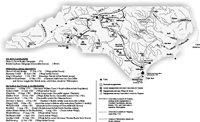Cherokee Are Again Enemies With the British in the American Revolution
Copyright discover
This article is from the Encyclopedia of North Carolina edited past William S. Powell. Copyright © 2006 past the Academy of North Carolina Press. Used by permission of the publisher. For personal use and not for further distribution. Please submit permission requests for other use directly to the publisher.
Is anything in this article factually wrong? Delight submit a annotate.
American Revolution
Part 4: Conflict with the Cherokees and British Invasion of the Due south
N Carolina witnessed lilliputian fighting within its boundaries from 1776 to 1780, with one exception. The Cherokee Indians in the western function of the colony were compelled to join forces with the British, who had promised to remove American encroachers from Cherokee land and, ultimately, to ensure greater tribal independence. In response to Cherokee attacks on Americans living in the western frontiers of Northward Carolina and Virginia, Gen. Charles Lee, commander of the Continental forces in the Due south, organized a coordinated attack on the Cherokee towns that populated the region. In the summer of 1776 Gen. Griffith Rutherford and 2,400 troops, backed by soldiers from Virginia and Southward Carolina, savagely fought and defeated the Cherokees in western Northward Carolina, leaving boondocks after town devastated and many survivors without basic necessities. The Cherokees finally surrendered and on xx July 1777 signed the Treaty of Long Island, in which they agreed to cede lands to the Americans and promised non to resume fighting.  Revolutionary War campaigns and battles. Map by Marker Anderson Moore, courtesy North Carolina Office of Athenaeum and History, Raleigh. (Click to view map.)
Revolutionary War campaigns and battles. Map by Marker Anderson Moore, courtesy North Carolina Office of Athenaeum and History, Raleigh. (Click to view map.)
Frustrated by their unsuccessful attempts to defeat America'southward Gen. George Washington in the North, the British in 1778 undertook a new strategy of crushing the independence move in the South. Gen. Robert Howe, the highest-ranking North Carolinian in the Continental Army, was commander of the entire Southern Department. When the British unleashed a powerful assault on Georgia in December 1778, however, Howe'southward defensive measures were inadequate. Savannah was the outset major southern town to autumn into British hands, with the rest of Georgia rapidly following. Howe was later court-martialed and forced to resign over his failure to protect the state.
The British next moved into South Carolina, which fell in plough. The loss of Charles Towne (now Charleston, S.C.) led to the surrender of Gen. Benjamin Lincoln and his unabridged Patriot army, which included 815 Continentals and 600 militiamen from North Carolina. At present nothing stood in the way of a British invasion of North Carolina. Governor Richard Caswell (1776-fourscore) and his successor, Abner Nash (1780-81), worked feverishly to prepare to meet the enemy forces, which were now commanded by Lord Charles Cornwallis. Caswell was placed in charge of the state's unabridged armed services forcefulness by the Due north Carolina General Assembly.
Although British victories in Georgia and South Carolina bolstered the spirits of N Carolina Loyalists, the defeat of the Tories at Ramsour's Mill (near present-day Lincolnton) and at Hanging Rock, South.C., impeded Cornwallis's efforts to subdue Due south Carolina and necessitated an invasion of North Carolina. The Continental Congress had tapped Gen. Horatio Gates, hero of the Boxing of Saratoga, every bit the human to cease Cornwallis. On 25 July 1780 Gates arrived at Hillsborough and causeless command of the Southern Department of the Continental Army. Gates led his 3,000 Continentals and ane,200 raw militia troops, under Caswell and Rutherford, on a poorly planned march to Camden, S.C. The troops had inadequate food, and many became ill on the long and difficult journey. On 6 August Gates and Cornwallis fought the Boxing of Camden, with disastrous results for the Americans. Many of the raw North Carolina militiamen panicked and fled the battlefield. The Continentals suffered 800 dead and 1,000 captured. Gates was forced to retreat to Charlotte and and then back to Hillsborough as Cornwallis prepared to launch his long-awaited invasion of Northward Carolina.
On 28 Sept. 1780 Cornwallis and his regular army entered Charlotte. North Carolina militia forces, led by Col. William R. Davie, harassed the British but could not stop them. Cornwallis was accompanied by the exiled Josiah Martin, who was so anxious to be reinstalled as majestic governor of N Carolina that he about immediately proclaimed the restoration of British rule. Just Martin's annunciation was premature. The people of Charlotte and the surrounding area did not welcome the return of imperial rule, as the British had hoped they would. In addition, a 1,100-human Tory force led by a British regular, Maj. Patrick Ferguson, was defeated by a forcefulness of nearly i,800 backcountry men along the North Carolina-South Carolina edge. The American victory, known as the Boxing of King'south Mountain, forced Cornwallis to change his plan to remain in North Carolina for fearfulness that in his absenteeism the same backcountry men who had defeated Ferguson would sideslip in behind him and retake Southward Carolina. Therefore, Cornwallis reluctantly returned to South Carolina. Rex's Mount saved N Carolina for the time being and bolstered Patriot morale throughout the 13 colonies.
Proceed reading >> Part v: Gen. Nathanael Greene and the Battle of Guilford Courthouse![]()
Additional Resource
Heaton, Charles. "The Failure of Enlightenment Military Doctrine in Revolutionary America: The Piedmont Campaign and the Fate of the British Ground forces in the Lower South." The North Carolina Historical Review 87, no. 2 (2010): 127–57. http://world wide web.jstor.org/stable/23523891.
one January 2006 | Davis, David K.; Lamm, Alan K.; Whittenburg, Carolyn Sparks
Source: https://www.ncpedia.org/american-revolution-part-4-conflict
0 Response to "Cherokee Are Again Enemies With the British in the American Revolution"
Post a Comment